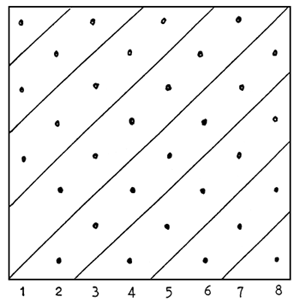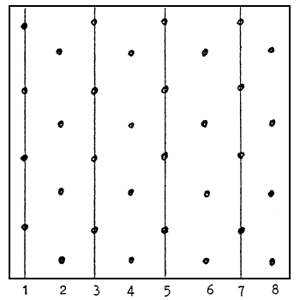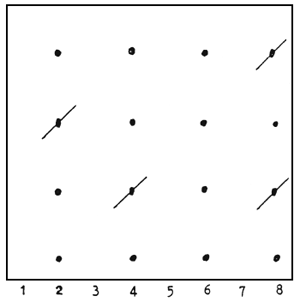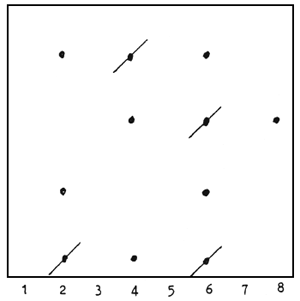At its 7th session in Rome in December 1989, the FAO Panel of Experts on Forest Gene Resources requested FAO to assemble together, for easy access, technical information published in a number of FAO documents and elsewhere, on the establishment and management of ex situ conservation stands. As a first step towards meeting this request, the present note summarizes information found in a number of published and unpublished documents, listed in the references.
Conservation stands may be established or demarcated either in situ or ex situ. Wherever security of land tenure is ensured in the natural range of the species/provenance, in situ conservation is an efficient method of conserving species/provenances. However, increased pressure on land and planned or unplanned change in land use have often rendered it difficult or impossible to conserve valuable species/provenances on their natural site. In such cases ex situ conservation will have to complement, or at times substitute for, in situ conservation.
THE NATURE OF EX SITU CONSERVATION STANDS
In contrast to agricultural food crops, in which storage and regular regeneration of seed constitutes a standard methodology of ex situ conservation, long-lived, outcrossing forest trees are biologically better adapted to conservation in live collection. The idea of establishing ex situ conservation stands was developed in the 1960's and 1970's, and consists of (i) random sampling of the population to be conserved; and (ii) the establishment of a number of stands of some 10 ha in size, kept separate from each other and from potentially hybridizing species and provenances, and managed and used for the production of seed and other reproductive materials. The individual ex situ conservation stands will during their lifespan be subject to varying natural and man-made selection pressures, and can thus be considered to correspond to the strategy of sub-lining and of developing multiple populations, recommended by Namkoong et al (1980), Namkoong (1982) and others, for minimal allelic losses over time in valuable forest tree populations.
CRITERIA FOR SELECTION OF GENETIC MATERIAL
Ex situ conservation stands are expensive to establish and maintain, and their use will thus be generally confined to species/provenances of proven socio-economic value. The strategy can also be used to safeguard species and/or provenances which are in danger of genetic pollution, for example from massive tree planting in their immediate vicinity of hybridizing species/provenances of non-local origins.
SITE
Security of tenure is of prime importance in the selection of sites. Due to genetic considerations (see above) and also as an insurance against loss, each species/provenance should be planted on a minimum of 2–3 sites. Adaptability of the species/provenance to the site must be proven, and the stand must be able to produce reproductive materials in the environmental conditions it represents (generally, and preferably, seeds). When possible, the sites chosen should also be representative of potential planting sites of the species/provenances in the country, thus increasing the immediate-term, economic value of the (long-term) conservation stands through potential production of seed for planting purposes. To facilitate protection and management of the stands, continued access to them must be assured. As the individual stands are expected to maintain population differentiation, they must, furthermore, be free from pollen contamination from outside sources, and must be isolated from potentially hybridizing species and provenances if subject to open pollination (see section on “isolation” below).
LAYOUT
The recommended plot size for ex situ conservation stands established for the maintenance of variation over many generations, and subject to open pollination, is ≥ 10 ha (e.g. 300 × 330 m). Smaller plots than 5 ha may not produce enough pollen to reduce stands contamination of pollen from outside. Furthermore, dangers of genetic drift will increase sharply with decreasing plot size. The shape of the plot will depend on topography and, above all, direction of prevailing winds; generally, however, to ensure adequate pollination within the stands, the shortest diameter should not be less than 150 meters. Recommended initial spacing in stands established with common plantation species, such as pines and eucalypts, is 3 × 3 m; this will allow for possible mechanical cultivation and later thinning. Additional guidance on layout can be obtained from e.g. corresponding recommendations on seed orchard design.
ISOLATION
As stressed above, to maintain population differentiation, ex situ conservation stands must be adequately isolated from contaminating pollen from outside sources, including hybridizing, or potentially hybridizing, species and provenances. The size of the conservation stands and, thus, the density of the pollen cloud generated by them, will have a decisive influence on potential pollen contamination, especially (but not exclusively) in wind-pollinated species, such as pines. Shape of the stand, as related to predominant winds during the flowering season, and land use around it, will also be important to consider. Thus, if winds during pollination are strong and consistent, it may be advisable to ensure that the “isolation strip” is wider on the windward than on the leeward side; regarding land use, it is evident that open ares surrounding the conservation stands are less efficient to screen off foreign pollen than e.g. a dense, multi-layered hardwood forest. As a rough “rule of thumb”, FAO has recommended that a minimum isolation strip of 330 m is needed around ex situ conservation stands.
NURSERY AND ESTABLISHMENT TECHNIQUES
Material destined for genetic conservation should be, and remain, representative of the source population from which it was derived. In consequence, the best, locally proven practices should be adopted in raising of the seedlings and in their outplanting so as to ensure maximum survival and vigorous growth. It may be advisable to adopt procedures which are somewhat more meticulous and, therefore, more expensive than normal routine measures to achieve this.
Procedures of sowing, pricking-out, watering, shading, weeding, root pruning, fertilizing, hardening off etc., should follow the best, proven techniques. Where erosion problems do not exist, site preparation by complete cultivation is the preferred procedure, especially in climates of low rainfall and long dry seasons. Stands should, whenever possible, be established on gentle slopes, on deep soils with good aeration, or otherwise optimal for development of the species to be conserved. Special attention should be given to lifting and transport of plants, e.g. thorough wetting before leaving the nursery, so that planting shock is minimized. Filling of possible blanks should be completed within 2–3 month after the initial planting. Local conditions will dictate the pioneer species, grasses, etc. which will appear after planting, and likewise the methods appropriate for their removal. Complete removal of weeds is strongly recommended as a precaution against fire damage during the early years.
EXAMPLES OF GUIDELINES FOR A SYSTEMATIC THINNING REGIME
In the 1970's, it was generally recommended that a thinning regime be devised which aims at maintaining the diversity of the original genepool in each ex situ stand throughout the life of the stand. If such maintenance of diversity is aimed at, the simplest way of achieving it is through the application of systematic thinnings, for example through the removal of alternate rows in one direction in the first (50 %) thinning; and alternate rows, at right angels, in the second (50%) thinning. A third thinning (50%) should be carried out in two stages, to prevent a sudden, drastic opening of the canopy as the trees will by now be relatively large. In stands planted at a spacement of 3 × 3 m, the succession of stockings in stems per hectare will be 1.111 (when planted), 555, 277, 207 and 138. An explanatory diagram of this specific scheme is shown in Figure 1.
Figure 1. Diagram showing sequence of thinning (Wood 1980)
| FIRST | SECOND |
 |  |
| THIRD (First Stage) | THIRD (Second Stage) |
 |  |
Although a fully systematic thinning method would be the most effective in conserving genetic diversity in any one stand, its strict application might result in the loss of superior phenotypes which could be of value in an ongoing, local breeding programme. Provision can be made for some flexibility in the thinning regime to meet such, immediate-term needs, e.g. by accepting that up to 10 selected plus trees per hectare be retained in the stand.
In relation to the above recommendations, elaborated by FAO in 1970's, it should be noted that provided conservation stands are established on a number of separate sites (>3) which possess varying environmental conditions, and are subjected to different selection criteria, systematic thinning may not be necessary to maximise their combined conservation value.; As changes in gene frequencies provoked by selective thinning will vary between the stands, the probability of overall allelic loss will, in fact, be smallest if each conservation stand representing a given population is subjected to strong selection pressure for different characteristics and traits.
CONCLUSION
The key to success in the use of ex situ conservation stands includes the following components:
REFERENCES
DANIDA Forest Seed Centre. 1984 Provenance Seed Stands and Provenance Conservation Stands. Compiled by R.L. Willan. Technical Note No. 14 - May 1984.
FAO 1977 Recommended prescriptions for the establishment and long-term management of ex situ conservation/selection stands. Annexes 7/1 and 7/2. In: Fourth Session of the FAO Expert Panel of Forest Genetic Resources. Held in Canberra, Australia, 9–11 March 1977. FAO, Rome.
Guldager, P. 1975 Ex situ conservation in the tropics. In: The methodology of conservation of forest genetic resources. FAO, FO:MISC/75/8.
Namkoong, G.; Barnes, R.D. & Burley, J. 1980 A Philosophy of Breeding Strategy for Tropical Forest Trees. Tropical Forestry Paper. No. 16. Commonwealth Forestry Institute, Oxford, U.K. 67 pp.
Namkoong, G. 1982 Challenging Tree Breeding Theory. In: Proceedings from IUFRO Joint Meeting of Working Parties on Genetics About Breeding Strategies Including Multiclonal Vararieties. Escherode/Sensenstein, Germany. pp. 155–161
National Research Council. 1991 Managing Global Genetic Resources, Forest Trees. National Academy Press, Washington, D.C. 228 pp.
Wood, P. 1980 Conservation of Forest Genetic Resources in Selected Countries in Africa. Report on Consultant Mission, FAO, Rome. 100 pp. (Unpublished).